Table of Contents
- What is pipeline management training?
- How to Train Your Team on Pipeline Management
- What does a healthy pipeline look like?
- The Benefits of Pipeline Management Training
- Online Courses for Pipeline Management
What is pipeline management training?
Pipeline management training means coaching your sales managers and broader sales team to build and oversee the pipeline. It involves coaching your team to spot bottlenecks early, predict revenue more accurately, and spend time where it counts most.
When you focus on pipeline management training, you’re giving reps and managers a solid game plan. They learn how to notice warning signs, adapt their approach, and keep every opportunity on track. They also get better at picking which leads deserve the most attention, sharing resources wisely, and adjusting their sales strategy based on real data.
In the end, strong pipeline management training sets everyone up for success. It explains the “why” behind each step in the sales process and keeps your team aligned, so you don’t lose deals to simple mistakes. This approach not only builds confidence but also keeps your sales cycle steady and predictable.
What does a healthy pipeline look like?
According to Gartner, most chief sales officers (CSOs) cite improving pipeline creation as their top priority. But how can your sales managers and team build a better pipeline if they don't know what a healthy one looks like for your organization?
Luckily, Jason Jordan, a sales management expert and co-author of Cracking the Sales Management Code, can help.
He recommends three metrics to assess pipeline health.
Metric 1: Size
Most sales managers err on the side of “bigger is better,” but smaller can actually be more productive. The reason is that smaller pipelines often have bad deals weeded out. It's also essential to tailor pipeline size to the individual salesperson rather than rolling out a team-wide mandate.
Metric 2: Content
A big pipeline isn‘t worth much if the prospects in the funnel aren’t aligned with the company’s goals. What prospects is your company trying to target? What products or services is it trying to sell? If those opportunities aren’t in the pipeline today, they won't be sold tomorrow.
Metric 3: Movement
Keep a close eye on prospects' progress and look for sticking points. If you can identify trouble spots, it naturally leads to a coaching conversation.
The Benefits of Pipeline Management Training
Now that you know what a healthy pipeline looks like, let's dive into why pipeline management training matters for your sales team.
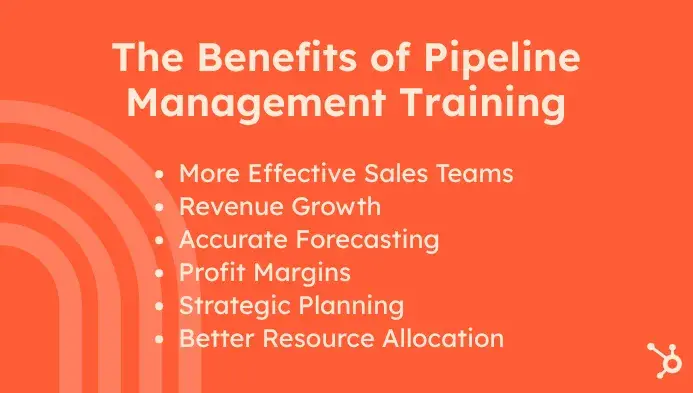
More Effective Sales Teams
When I was fresh out of university, I got my first “real” job as an admin in a local college's business development (BD) department. I was bright-eyed, bushy-tailed, and had no clue about BD or admin. I was, however, fortunate enough to work under a business development manager who was previously an IT tutor. Because of her background, she was incredible with systems and processes.
But she had been away on maternity leave, making my first week on the job her first week back. During her absence, the reps had been left unmanaged and half-heartedly kept up with data/admin. Process-wise, the department was a mess.
Each sales rep had a different system to track the pipeline and manage accounts. That meant they would sometimes chase the same leads, and key accounts weren't nurtured because the reps were too busy chasing new business. It was also a nightmare for the BD manager to track progress and report to other departments or, even worse, the college directors.
After about a week, the BD manager set us both a task to create a master spreadsheet for tracking new leads. She also trained me in data entry, Excel, formulas, and how to source, qualify, and track leads related to the spreadsheet.
I was then in charge of this area going forward. This allowed me to generate more leads in the background, even when the reps were busy in sales meetings.
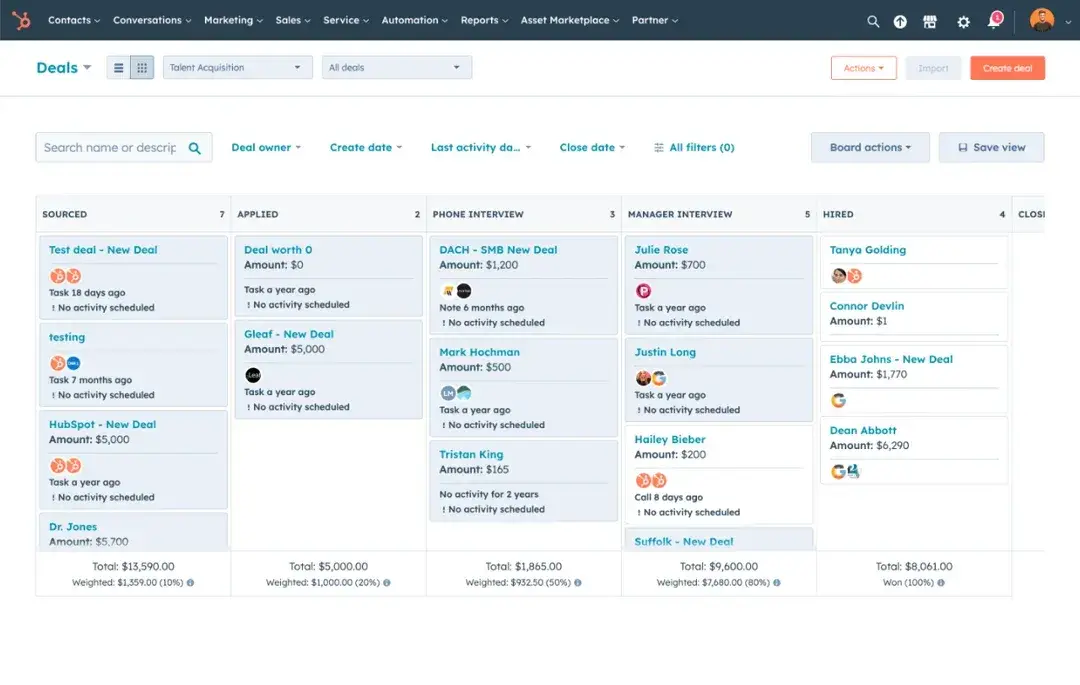
We also invested in a CRM to track individual pipelines from start to finish. We got caught up with the backlog between ourselves. After that, once a month, the BD manager would deliver pipeline management training for us all in the morning. Then, the reps would do pipeline management through the CRM in the afternoon.
The BD manager was more effective because she could track team-wide pipeline progress and spot new opportunities. I was more effective as an admin because I wasn't constantly chasing reps to deal with a pipeline backlog. I could then focus that time on helping generate new leads for the sales reps.
The reps were more effective because the training and processes gave them clarity. That meant they never let a qualified lead or upselling opportunity slip through the net.
Pro tip: A pipeline management tool, like HubSpot's pipeline management software, can track every deal in one place, allow you to customize your pipeline based on buyers’ needs, and point out where to focus your efforts. This way, your team can spend less time guessing and more time selling, leading to a stronger, more effective sales operation.
Revenue Growth
“Pipeline management is one area that’s particularly important for sales managers to be trained on. Why? Because it impacts the bottom line,” says Jason Jordan.
When you give sales managers the right training to spot stalled deals and resolve roadblocks, you create a positive chain reaction. Reps know where to focus, time is spent more wisely, and deals don’t slip through the cracks. The results show up in your revenue figures.
Good pipeline management keeps sales on track and gives you greater control over your forecasts, so you can make better plans for growth. It also helps managers find the best approach for each rep, turning average performers into high achievers and consistent earners.
Accurate Forecasting
“Pipeline management training is so beneficial because it allows us to keep our pipeline up to date, therefore improving our ability to forecast,” says Revenue Operations Manager at Qwilr, Dustin Martin. Martin also emphasizes the importance of having all sales team members operate under the same pipeline assumptions.
When everyone agrees on what each pipeline stage means and updates deals in real time, you get a single source of truth. This consistency not only builds trust in your pipeline data but also helps you spot trends early and plan ahead. You’ll then have “a reliable metric that should directionally be able to help the business anticipate future results and plan accordingly.”
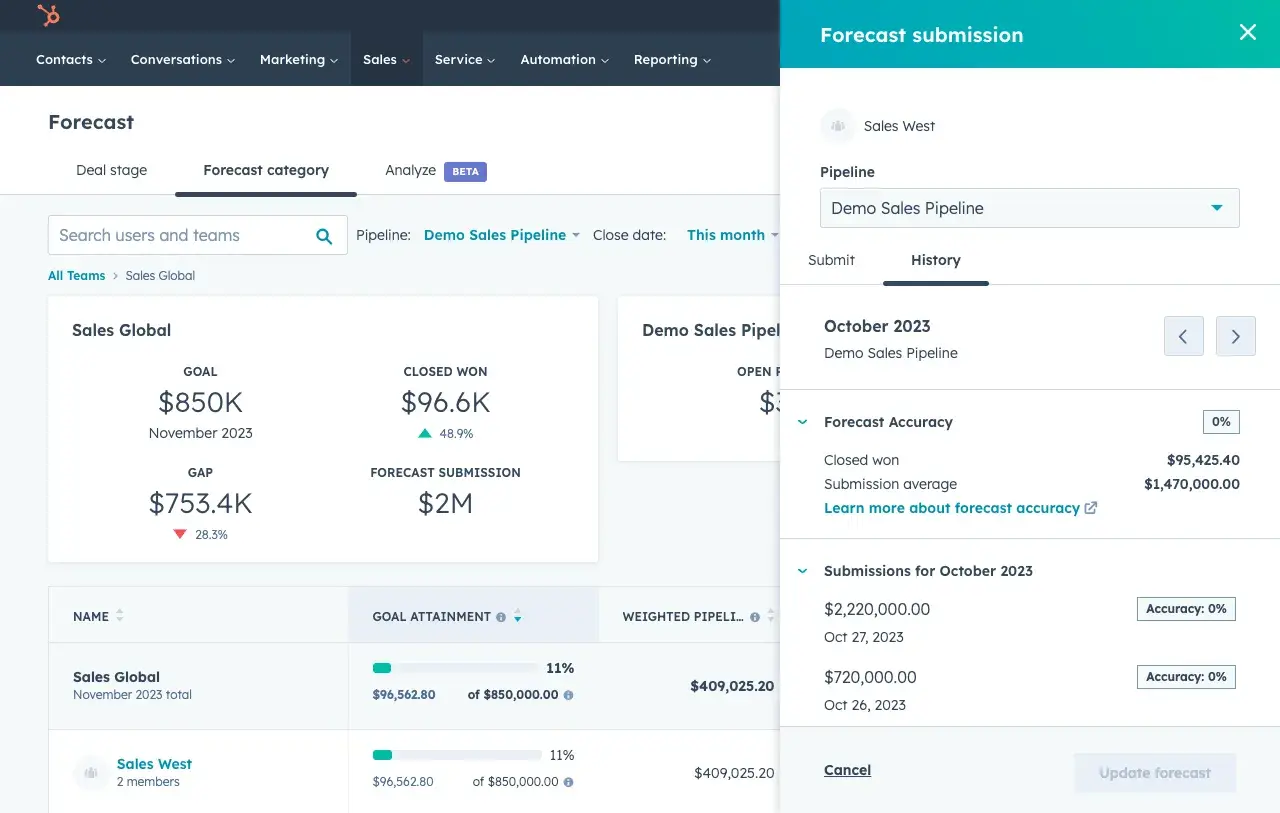
Pro tip: You can use forecasting tools to improve your forecasting results. For instance, HubSpot’s customizable and easy-to-use forecasting software gives you a holistic view of your entire pipeline, so you can quickly see how your month/quarter is shaping up and check deals to ensure your team stays on track.
You can also view monthly or quarterly revenue, while service teams monitor renewals and upgrades in their own pipeline. The tool also tracks performance metrics and connects with sales analytics to give you a complete picture of your team’s progress.
Profit Margins
“Your sales pipeline is what pumps life into your revenue stream,” says Vito Vishnepolsky, founder and CEO at Martal Group.
“Think about how much each lead costs your company. In B2B sales, paying $200 or more per lead is not uncommon. Now, imagine losing half your leads due to a faulty pipeline. How deep would that cut into your profit margins?"
Even with all the technology available, automation doesn’t always catch every issue. As Vishnepolsky points out, it can miss the mark nine times out of ten when it comes to effective pipeline management. That’s why it’s so important to train your sales teams to identify weak spots themselves.
This hands-on approach not only saves you from wasting money on lost leads but also keeps your profit margins strong.
Strategic Planning
“As a small startup, we're very agile, and we have already changed direction multiple times in reaction to market conditions,” says Louise Horscroft, former commercial director at AquaSwitch.
“There is no set recipe for strategic planning at a startup, so besides understanding the key aspects — lead numbers, lead conversion rates, etc. — the rest is learned on the job."
Because so much is learned on the job, Horscroft cites pipeline management training as a way to help you plan more strategically. Even if you train people on the job, it helps you handle the unknowns of being a startup by teaching your team to see potential hurdles before they become major issues.
Whether you’re a startup or a corporation, accurate forecasting and a well-managed pipeline support smarter decisions. When you base your plans on what your pipeline actually looks like, instead of what you hope it will be, you’re more prepared for whatever comes your way.
Better Resource Allocation
As a result of pipeline management training, Horscroft enhanced the way AquaSwitch distributed its sales team. Vishnepolsky reports a similar experience. “Through training, your sales team is equipped with everything they need to keep your lead data accurate and applicable so you can allocate your resources accordingly,” he explains.
Part of that is because a well-managed pipeline makes it easier to predict which leads and opportunities will close. Sales managers can then allocate resources against the goals of the pipeline while factoring in higher-priority leads.
How to Train Your Team on Pipeline Management
- Don't neglect existing sales managers.
- Make the training hands-on.
- Establish what a pipeline is and set clear expectations.
- Go over CRM/admin best practices.
- Include key parameters and sales fundamentals.
- Don't confine all learning to the classroom.
- Focus on continuous improvement.
- Embed the training through rep check-ins.
From prospecting to winning or losing the deal, the pipeline should align with your business goals and values at every stage.
Here's how to train your team on pipeline management to help you achieve that and convert more prospects into purchasers.
Don't neglect existing sales managers.
“Sales managers often get selected and promoted for being exceptional reps, but just because they‘ve mastered one role doesn’t mean they're naturally adept at the other,” says Jason Jordan.
Jordan explains that sales management includes coaching, creating forecasts, running reports, and many other things reps don‘t have in their job description. That said, there’s a common assumption that if a company promotes its best salespeople, those former sales reps will just figure it out. But Jordan doesn't think this is true.
“From my perspective, new sales managers promoted from the rep level should be treated as new hires and trained as such. Our observation is that organizations spend a lot of time teaching managers on the sales methodology and showing them how to work in the CRM, but they don't get much in the way of practical training.”
Make the training hands-on.
Every sales team I’ve ever worked on has been high energy, with most reps having outgoing personalities. Now, that’s not to say only outgoing extroverts work in sales. I‘ve met some incredibly talented salespeople who would tell you they’re naturally introverted.
That said, an extroverted salesperson won‘t appreciate being buried in manuals for hours. And in my experience, endless theory isn’t a great approach to sales training, regardless of personality type. So, if you want your pipeline management training to work, make it hands-on.
Of course, you don‘t want to skip the theory entirely — it matters. But don’t have your sales team reading handouts for hours. Instead, deliver a bit of theory and then embed the learning with practical activities. Get your team using new tools (or existing tools in new ways) and working on actual leads at various stages of the pipeline.
Establish what a pipeline is and set clear expectations.
Coaching up a team on pipeline management requires discussing what constitutes a pipeline in the first place,” says Dustin Martin. Martin explains that pipeline is a confidence metric, and if the pipeline is inflated, the business will have unwarranted confidence.
Your team needs a shared understanding of what belongs in the pipeline — and what doesn’t. When everyone has different ideas about what counts as a legitimate deal, the pipeline becomes unreliable. That’s why Martin emphasizes the importance of clarifying exactly what criteria a deal must meet to enter your pipeline.
“After that, make it clear what requirements must be met to advance a deal, and discuss how to appropriately size a deal,” he continues.
By setting clear guidelines upfront, you help reps make better decisions about which opportunities deserve their attention. The result is a pipeline you can actually trust — and more accurate forecasting for your business.
Go over CRM/admin best practices.
Martin also emphasizes that consistency is vital when it comes to CRM use. “Make the fields known and required in Hubspot so that everyone is filling out the same data in order to create and advance the pipeline,” he says.
Of course, that‘s easier said than done. As a former admin for a lovably rowdy business development team, I can tell you firsthand that some salespeople just don’t like admin or data entry. Whether it’s updating spreadsheets, filling out the CRM, or carefully crossing the t’s and dotting the i’s on paperwork, it’s just not their thing.
Advanced Pipeline Management in HubSpot (Combining Deals with Workflows)
I overcame this hurdle by clearly showing how doing these tasks actually improved sales results. I'd explain that, yes, entering data might feel mundane. But correctly filling out CRM fields could be the difference between banking your commission in two months or waiting six months to see that money.
This was especially true for our sales team in the public sector. Any missing data meant compliance wouldn‘t clear the paperwork. That delayed reclaiming funding, which then delayed reps from getting their commission checks. Even in the private sector, other departments often need clear data to approve commission payments. How can they confirm a deal has closed if there’s no clear record in the CRM?
Include key parameters and sales fundamentals.
“At AquaSwitch, we‘re all about data, so I’ve taken a lot of time training my sales reps on keeping track of key parameters to have the ‘big picture’ when making key decisions and managing expectations,” says Horscroft.
In real life, this means tracking things like average deal size, sales cycle length, conversion rates between pipeline stages, and win rates. With these numbers in hand, reps can make smarter decisions about where to focus their time and energy.
Martin mirrors this approach. “You must get the team to agree across the board on what metrics and qualifications to rely on,” he says. Doing this is essential to keep everyone “working in the same way.”
There are so many different metrics and KPIs to track, so your reps have to decide as a group which KPIs matter most to your pipeline, such as the volume of leads entering the pipeline weekly, response times to inquiries, or specific qualifications for moving leads forward. When your whole team aligns around these metrics, there's less confusion and more predictable results.
Horscroft emphasizes that experience remains paramount here. That's because “differentiating soft versus hard leads still leans on intuition.” Even with clear data, reps still need good judgment to understand which deals have real potential versus those that look good on paper but might not close.
Still, you must recognize specific key indicators and sales metrics within pipeline management training. If we’re following Jordan’s advice to assess pipeline health, these might include the overall size of your pipeline (number of active deals), pipeline content (deal quality), and movement (velocity of deals progressing).
Aside from outlining and tracking key parameters, other fundamentals to include in your training would be sales phrases, lead qualification methods, lead nurturing strategies, and accurate sales forecasting. These areas help get everyone on the same page, so you can manage your pipeline more effectively as a sales team.
Don't confine all learning to the classroom.
“At AquaSwitch, we operate with a compact sales team, and most training unfolds on the go,” says Horscroft. She explains that because their sales team is small, they must be agile in all areas. Part of this ‘on the go’ approach means constantly collaborating to “refine our pipeline 'habits’.”
An informal style works well because pipeline management isn't static — it evolves daily. By talking regularly about real-world deals, challenges, and successes, your team learns to manage their pipeline naturally. It becomes part of their everyday conversation rather than something isolated to occasional training sessions.
Vito Vishnepolsky takes a similar stance. “We have a remote team of over 50 sales executives, all in different regions and time zones. As you may assume, it's not always easy or practical to schedule team training sessions.”
To counteract this, Vishnepolsky recommends amassing a repository of online training videos. Having resources available on demand lets your reps access relevant guidance exactly when needed. He also emphasizes that quick and comprehensive answers trump formal classroom-style training every time when it comes to pipeline management training.
When your team members can quickly find answers to specific questions, like how to handle a stuck deal or qualify a lead, they’re more likely to use and retain the information.
Focus on continuous improvement.
“My biggest tip for training is to make sure to cover the technical basis and to make sure everyone has the ‘forever learner’ attitude,” says Horscroft.
“We‘re all constantly picking our heads as to how we can improve our sales. Technology is moving much faster than any traditional salesman can keep up with, so it’s all about research.”
Vishnepolsky shares a similar attitude, but from the perspective of updating and improving the training itself. “Don't look at your online training as a set-it-and-forget-it solution,” explains Vishnepolsky. “Continually update your modules to reflect your current best practices; otherwise, your team will lose confidence in the training or adopt outdated processes.”
Embed the training through rep check-ins.
“Now that you know how to assess a pipeline, you should sit down with each rep -- ideally 3-4 hours per month -- and talk through their funnels,” says Jordan.
He explains that your pipeline management meetings shouldn‘t be the sales manager and rep scrubbing data for an hour. That’s just inspection for inspection's sake.
“Instead, pipeline management should be proactive and forward-looking. Managers should focus on just a few deals and dig into the particulars with the reps so they can have an impact on the outcome,” Jordan explains.
Online Courses for Pipeline Management
In this section, I’ll share five online courses for pipeline management, including the pricing, course content, and what I like about the training.
1. HubSpot Sales Hub Software Certification Course
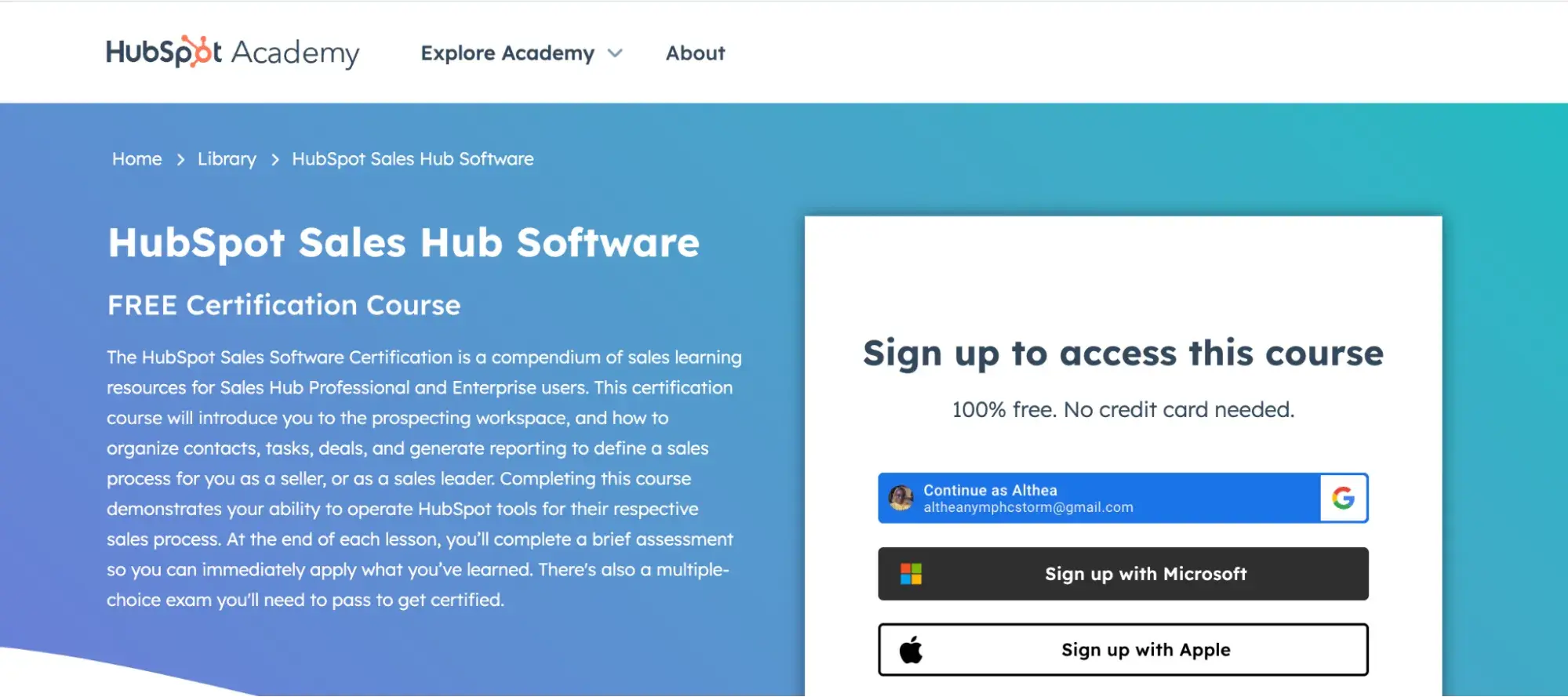
This two-hour certification course is ideal if your sales team wants to master HubSpot's Sales Hub and its core pipeline management tools, like:
It covers everything from the basics to advanced strategies, introducing you to the prospecting workspace and teaching you how to effectively organize your contacts, tasks, and deals.
The course helps you clearly define and manage your sales process, whether you're a sales rep or leading the whole team. You’ll learn how to generate insightful reports to stay on top of pipeline progress and performance. Each lesson includes a quick assessment, letting you apply your new skills immediately. To earn your certification, you’ll complete a final multiple-choice exam at the end.
Completing this course proves your proficiency in using HubSpot Sales Hub and gives you practical skills to manage your sales pipeline confidently and efficiently.
If you want a longer course, check out this 5-hour free course from HubSpot Academy: HubSpot Sales Hub Tutorial.
Other sales-related courses:
2. LinkedIn - Sales Pipeline Management
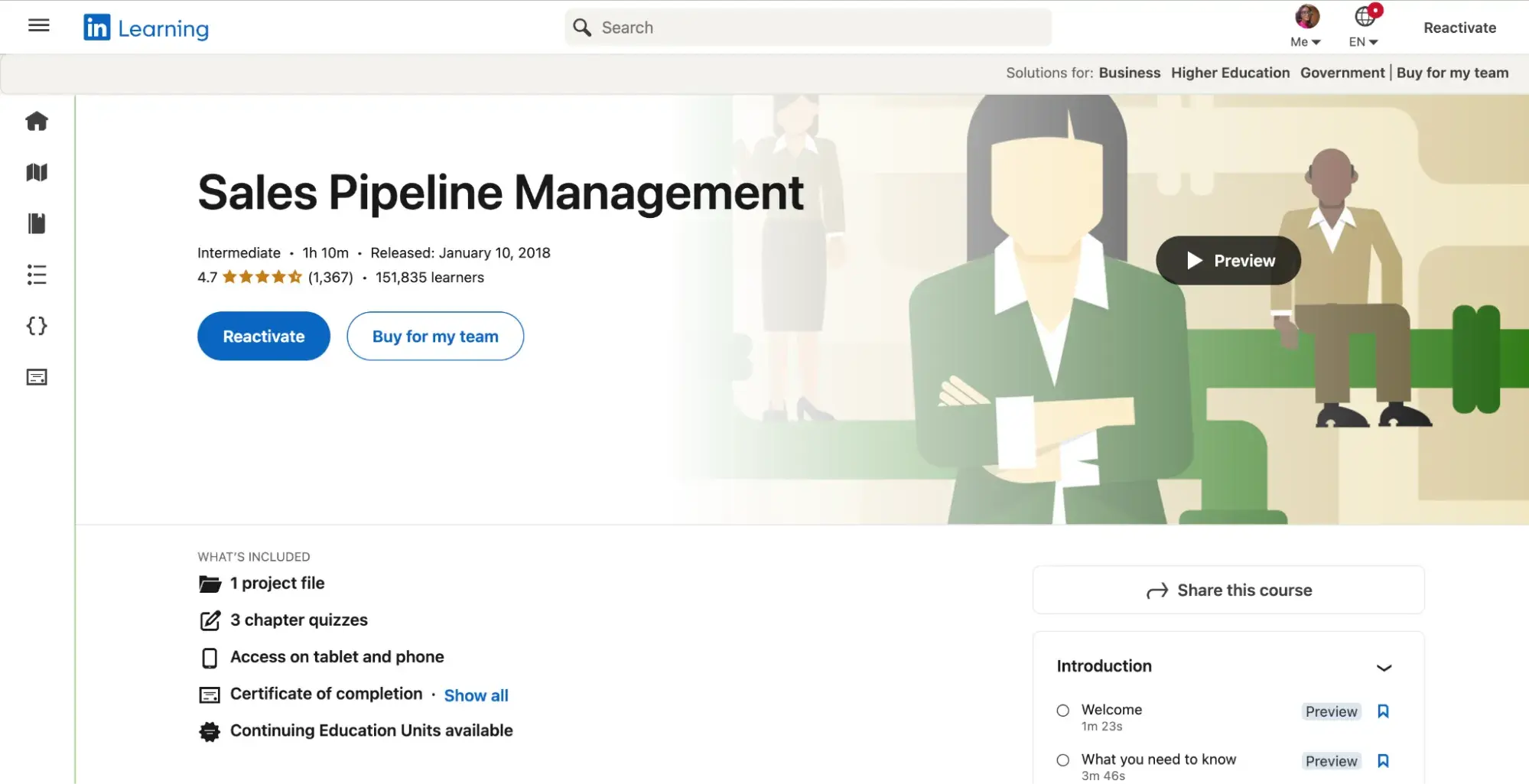
If you‘re a LinkedIn Premium member, you can do this course for free within your membership. If not, Sales Pipeline Management costs $29.99 per learner. The course has three chapters:
- Sales Foundations explores the sales process, how to set up a sales pipeline, and how to use a spreadsheet and CRM to track the pipeline.
- Pipeline Structure and Stages explores finding and developing prospects, cultivating opportunities, solving buyers’ needs, and closing the sale.
- Review, Analysis, and Essential Metrics for Pipeline Management explores sales forecasting, proper pipeline maintenance, decision-making, and analysis (including how to interpret dashboards)
I‘ve always had great experiences with LinkedIn Learning, personally. Then, as a manager, I’ve used the tool as an accessible way to train my team. Because of that, this course was first on my list to preview.
At first glance, I like how in-depth the training is. Plus, the trainer, Dean Karrel, an expert in sales training, includes practical examples, which are great because they help the learning stick.
3. Reed - Sales Forecasting and Pipeline Management Masterclass
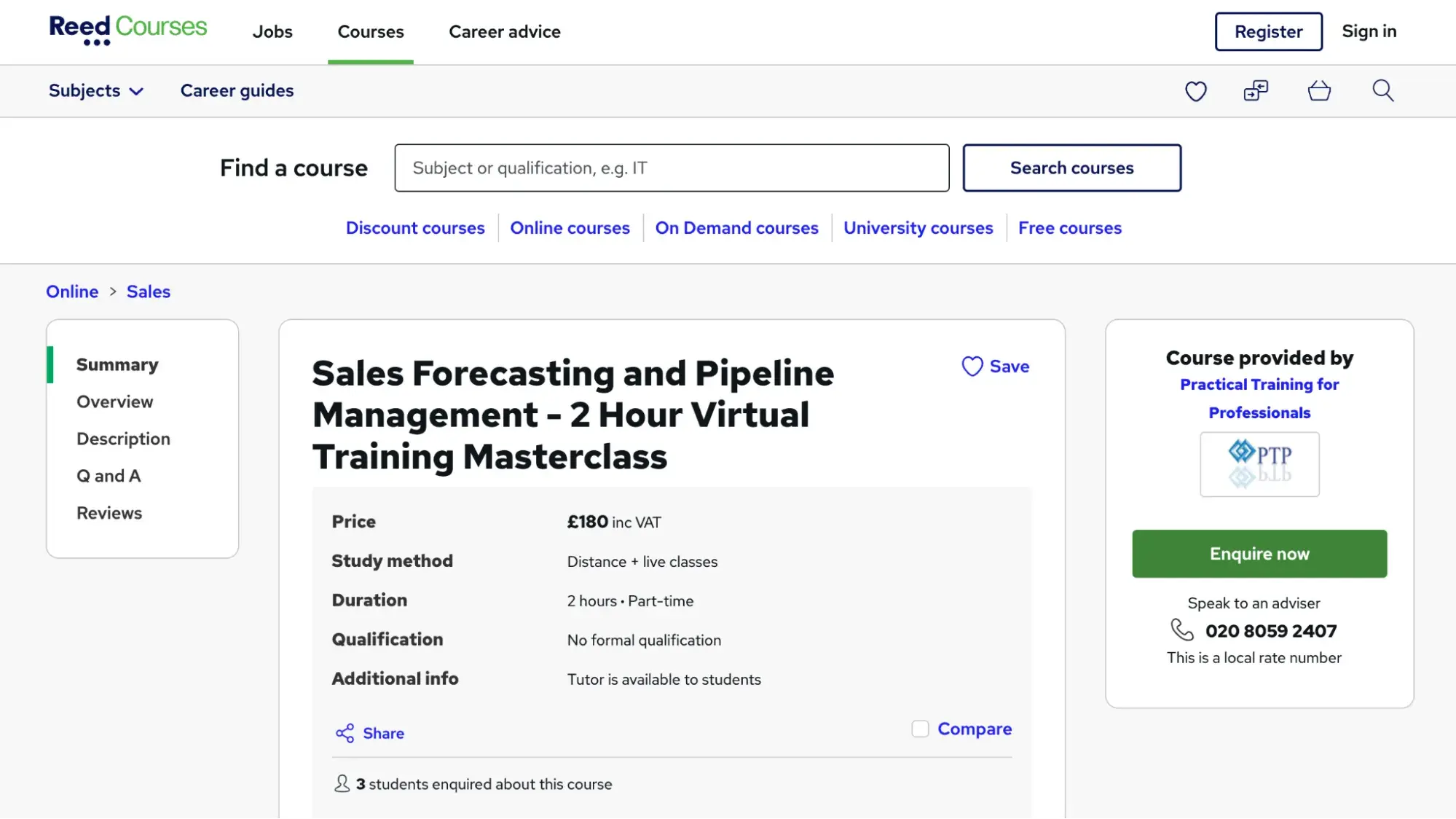
Reed‘s Sales Forecasting and Pipeline Management course is a two-hour virtual training session that costs £180 (about $220). The training is divided into four parts:
- What is the impact of sales forecasting?
- Which factors affect sales trends?
- The importance of monitoring actual sales against forecasted sales.
- Understand the importance of pipeline management.
I think this course is an excellent addition for sales managers who want to understand how pipeline management impacts forecasting, specifically. I also like that the course shows participants how to build a market picture by analyzing actual against forecasted sales.
4. TalentLMS - Managing Your Pipeline
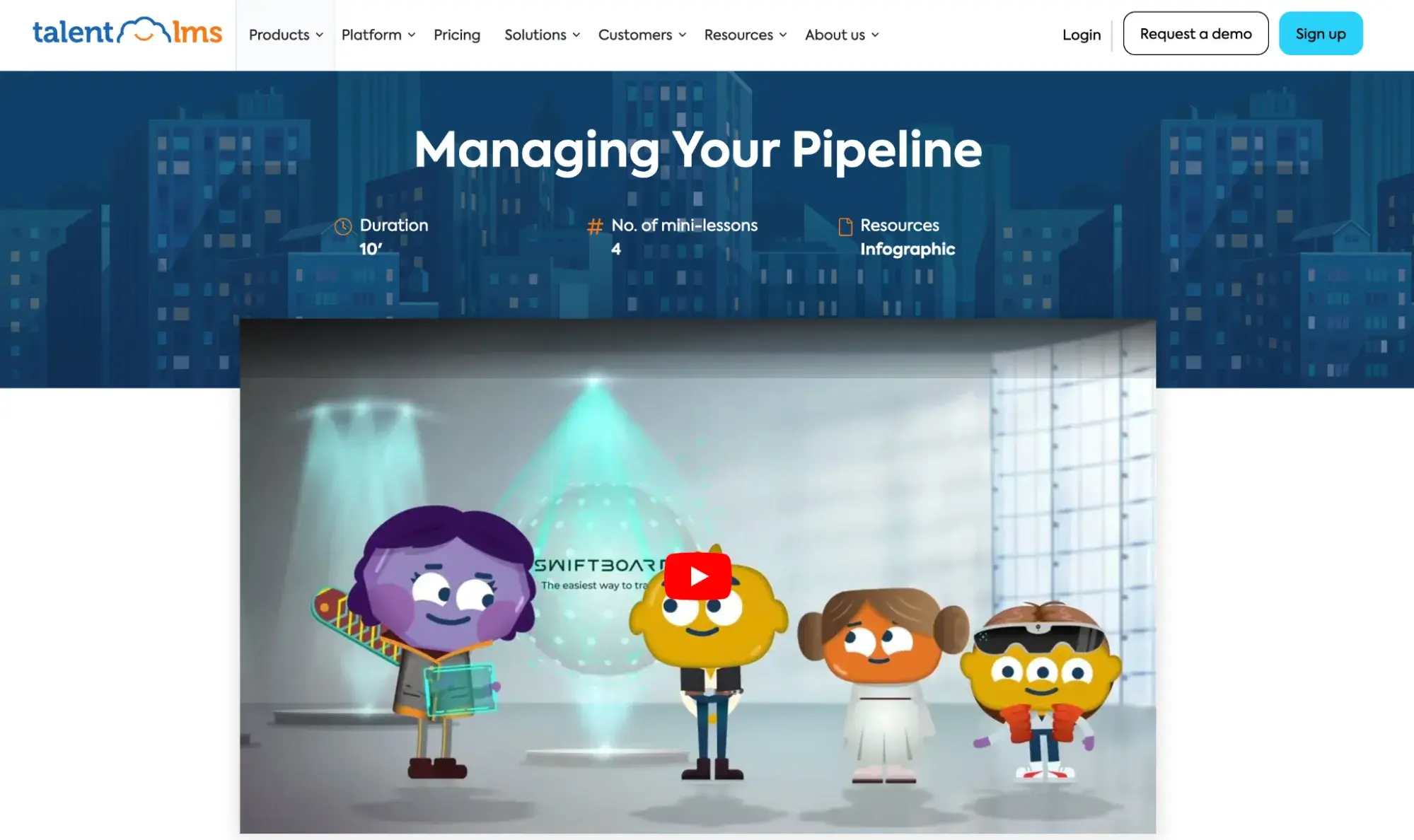
You can access ‘Managing Your Pipeline’ from TalentLMS through their membership offer. Memberships start from $109 per month for unlimited courses covering up to 40 users. The training covers three main areas:
- Assessing which leads to follow through on.
- Constructing a time-management plan to meet critical targets.
- Tools to help manage the sales pipeline.
I like the fact that TalentLibrary is accredited by the Continuing Professional Development (CPD) Certification Service. As someone with a background in education and training, I know this is generally a good indicator of course quality.
I also like that it caters to anyone in the sales world. That means as a sales manager, you can take the training yourself and assign it to your reps, too. Your sales reps can then see their pipeline from a different perspective.
5. Richardson Sales Performance - Reviewing Pipelines
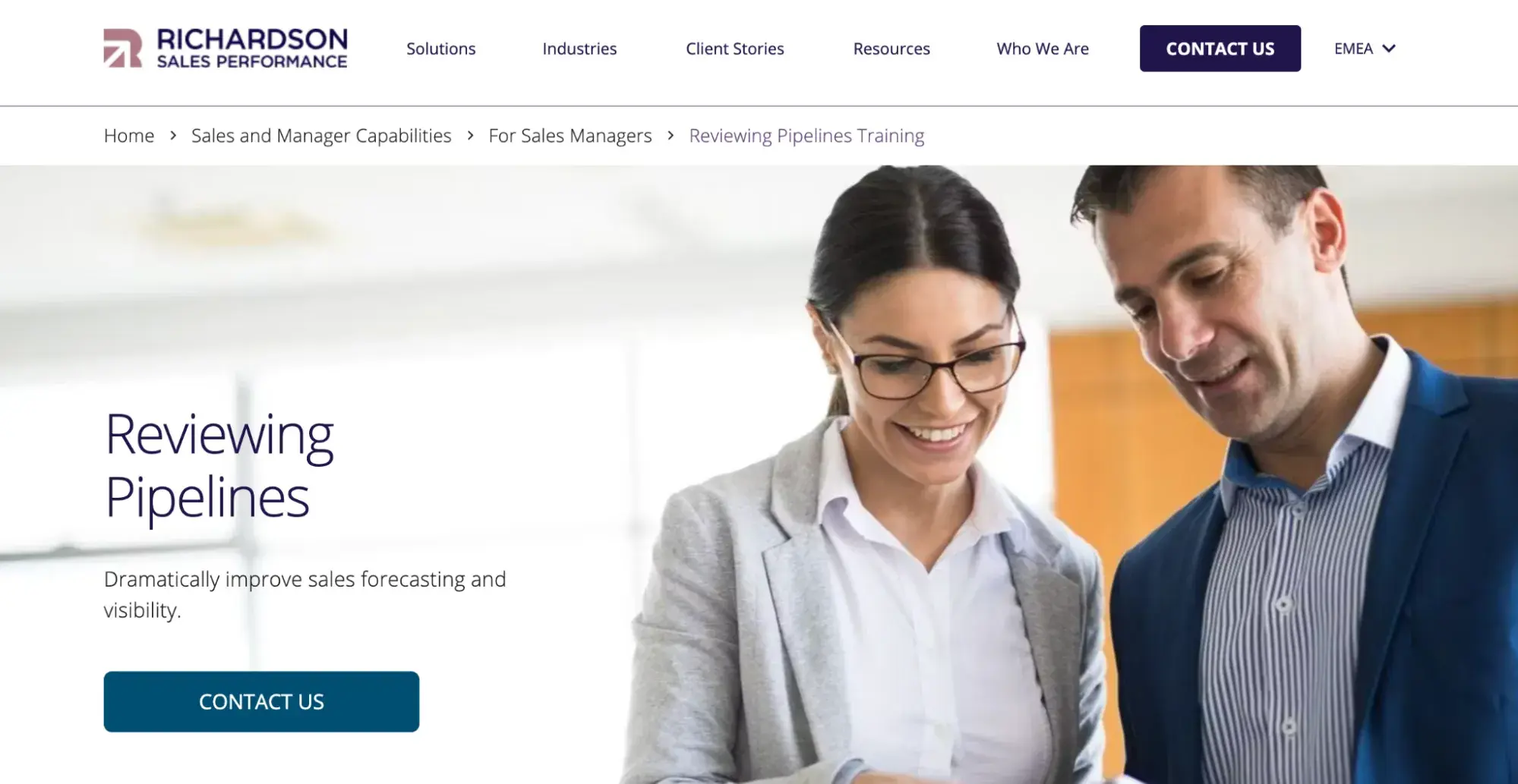
‘Reviewing Pipelines’ is a virtual instructor-led course explicitly aimed at sales managers and leaders. You have to contact them directly for course prices. The training covers four key content areas:
- Evaluate Sales Pipelines for Consistent Productivity. This section provides the tools that help managers evaluate the size, quality, and velocity of pipelines and determine what they need to do to hit (and exceed) their sales objectives.
- Develop the Sales Team’s Skills. This section provides data-backed methods and tools that help sales managers identify the specific skill(s) that each sales rep needs to improve upon.
- Forecast Accurately. This section shows sales managers ways to estimate their team’s anticipated results accurately.
- Establish an Effective Sales Management Cadence. This section helps sales managers establish a consistent cadence of sales inspection, review and coaching, and set clear selling standards for the entire team.
I like that this training focuses specifically on coaching sales managers. I also appreciate how managers will be able to find relevant skill development opportunities for their teams through pipeline analysis training.
Enhance Your Sales Team with Pipeline Management Training
While some might believe selling is, in part, a natural talent, companies still devote between $1,000 and $1,499 per sales rep to sales training on average. It’s up for debate whether the amount of training reps receive is enough, but still, it happens. What doesn’t happen nearly as frequently or thoroughly is pipeline management training.
From increasing sales manager effectiveness to increasing revenue and protecting profit margins, many expert/data-led reasons exist to buck this trend. You can follow our guide if you want to train your sales managers and broader team to manage pipelines more effectively. Alternatively, you can try one of the recommended courses above.



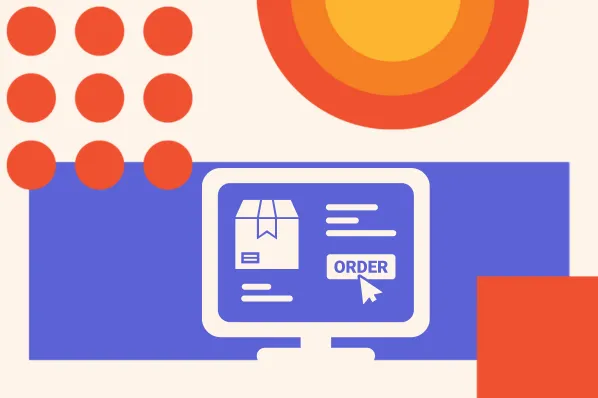

.jpg)

![5 Reasons Why Sales Teams Miss Revenue Targets [+ How to Meet Them]](https://53.fs1.hubspotusercontent-na1.net/hubfs/53/revenue-targets-1-20250224-8507178.webp)


.jpg)
